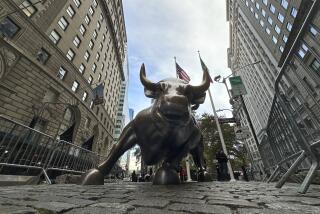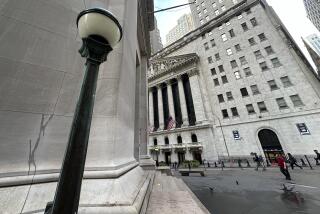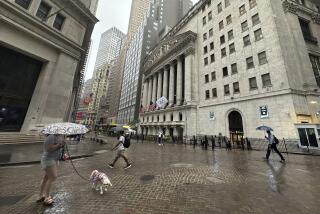Investors learn a lesson as stock index hits high
THE STANDARD & POOR'S 500 INDEX â a stock market benchmark for the retirement savings of millions of Americans -- hit an all-time high Wednesday, raising hopes that Wall Streetâs 4 1/2 -year rally will keep on rolling.
But for many average investors, the event is a painful reminder that a key part of their portfolios has done little better than break even over the last seven years. The S&P; index has just regained the last of its nearly 50% decline from 2000 to 2002, when plummeting shares of technology companies led the market down in the worst slump since the Great Depression.
âIt illustrates just how much damage a bubble can doâ to investorsâ portfolios, said Russ Kinnel, director of mutual fund analysis at Morningstar Inc. in Chicago.
The travails of the S&P; index matter because about $1.3 trillion is invested in funds that seek to mimic the overall performance of its 500 stocks. That includes pension fund accounts as well as S&P; 500 mutual funds that are popular options in 401(k) retirement plans.
The index is a much broader measure of Wall Street than the better-known Dow Jones industrial average, which includes just 30 stocks.
The long, slow recovery of the S&P; 500 has been a wake-up call for Mary Cleve, a 53-year-old escrow agent in Dallas.
When the market began to dive in 2000, Cleve trusted Wall Streetâs standard advice: Be a long-term investor. It never occurred to her, she said, that âlong-termâ meant she would have to wait quite this long simply to get back to where she started with shares of premier U.S. companies.
Yet many financial advisors say there has been a silver lining in the troubles of the S&P; index. Americans now understand the need to maintain a well-diversified investment portfolio, including small-company stocks, foreign issues, bonds, real estate and cash accounts.
In 2000, by contrast, many investors were comfortable with little more than U.S. blue-chip issues and tech stocks.
âYouâd talk to people about diversification, but they didnât want to hear,â said Geordie Crossan, president of NBS Financial Services, an advisory firm in Westlake Village.
Small-company and foreign shares, in particular, have been big winners in recent years, after badly lagging behind the S&P; 500 stocks in the 1990s.
To some extent, big-name U.S. stocks in this decade have been victims of their great success in the 1980s and 1990s. Investors were so enamored of the companies by the late 1990s that they pushed the stocks to unprecedented levels compared with the companiesâ earnings.
That was particularly true of technology shares, the mega-stars of the 1990s, but also for stocks of other big companies in the S&P; index, such as General Electric Co. and Coca-Cola Co.
When earnings collapsed during the 2001 recession, many investors fled shares that suddenly appeared overvalued. The terrorist attacks of that year and the corporate scandals of 2002 compounded the miseries of blue-chip stocks.
From its 2000 peak, the S&P; index dived 49%. The drop had wiped out $6 trillion in stock wealth by the time the market bottomed out in October 2002.
Except for a few hiccups, the index has risen steadily since then -- nearly doubling from its low. On Wednesday, it rose 12.12 points to close at 1,530.23. That topped the previous peak of 1,527.46 reached March 24, 2000.
Many of the tech stocks in the index, however, remain far below their 2000 peaks even though they have rebounded since 2002.
Standard & Poorâs, which created and maintains the index, has been criticized by some Wall Street pros for having allowed volatile tech shares to become such a big part of the index in the late â90s. But the firm said it had no choice: As investors swarmed into tech issues, they boosted their importance in the market as a whole, obligating S&P; to add more of them to the index, said Howard Silverblatt, a senior analyst at the firm.
âThe S&P; 500 emulates the market -- good, bad or indifferent,â he said.
But the âbadâ has taken a heavy toll on the nest eggs of some middle-aged and older investors.
Cleve had owned a fund that tracked the S&P; 500. After the 2000-02 slump cut her retirement account assets in half, she said, the only reason she and her husband have gained ground over the last seven years is that theyâve been saving frantically to recover.
Still, Cleve believes that if it hadnât been for a recent inheritance, her retirement prospects would have been shattered.
âI see all these 70-year-olds working at McDonaldâs, and it scares me to death,â she said.
Phyllis Wilcox, a retired nurse from Placentia, said she panicked when stocks dropped earlier this decade.
âI know it was stupid, but prices kept going down, down, down, and it was so hard not to sell,â she said.
Wilcox, 73, took assets out of a stock fund that tracked the S&P; index and put the cash into a money market fund -- a decision that she figures cost her about $10,000.
âIf I had been patient, the fund would have recovered and I would not have had to suffer the loss,â she said. âI just suffered an anxiety attack.â
For Wall Street, the record close on the S&P; is a milestone in the new bull market. The index has been among the last of the major market gauges to recoup their bear-market declines.
The blue-chip Dow Jones industrial average surpassed its 2000 peak in October.
After taking inflation into account, the S&P; still is below its old high, although investors have earned a small amount of dividend income since 1999.
Some analysts believe that the lagging performance of many big-name companies in the S&P; index has made them relative bargains. Stocks such as GE and Wal-Mart Stores Inc. could now take the lead on Wall Street if the global economy continues to expand, their fans say.
A common measure of a stockâs value is its price-to-earnings ratio, which is the share price divided by annual earnings per share.
The price-to-earnings ratio of the S&P; index is about 17, according to Standard & Poorâs. That is far below the indexâs peak price-to-earnings ratio of about 31 at the end of the last bull market. The ratio has come down because earnings have gone up faster than the stocksâ prices.
âPeople gave up on a lot of these companies,â said Robert Bissell, president of money manager Wells Capital Management in Los Angeles.
Now, big-name stocks are back in vogue, partly because of their global reach. Although the domestic economy has slowed sharply, growth still is revving in many countries overseas.
âThat will favor some of these large companies that have tentacles all over the world,â Bissell said.
So far this year, the S&P; 500 is up 7.9%, beating the 7.1% gain of the Russell 2,000 index of small stocks.
Whatâs more, the record earnings racked up by major companies in recent years have left many of them flush with cash. They are increasingly putting that money to work buying back their own shares in the market, based on the belief that their stocks are undervalued. That buying has helped drive up prices.
So, too, has interest on the part of so-called private equity firms as takeover activity surges. More than a dozen companies in the S&P; 500 have buyout bids on the table from these investment partnerships.
Amid a roaring bull market worldwide, some analysts consider U.S. blue chips a safer choice today than smaller stocks and emerging-market issues. Thatâs based on the assumption that if markets overall suddenly faced a major sell-off, blue chip stocks would fall less, because they havenât moved up as much as more speculative issues and their earnings often are more predictable.
*
*
Begin text of infobox
Then and now: Big names in the S&P;
The Standard & Poorâs 500 stock index Wednesday finally closed above its peak reached in 2000. Although technology stocks remain well below their levels at the indexâs 2000 zenith, many non-tech issues have gained since then.
*--* Stock March 24, 2000 Wed. Pctg. change Altria $14.87 $71.49 +381% Procter & Gamble 28.00 63.85 +128 Exxon Mobil 38.63 84.00 +117 Citigroup 42.25 55.20 +31 American Intl. Group 71.75 72.09 +0.5 IBM 120.62 106.93 -11 Pfizer 34.88 27.41 -21 General Electric 53.02 37.73 -29 Microsoft 55.84 31.11 -44 Cisco Systems 79.38 26.39 -67 S&P; 500 index 1,527.46 1,530.23 +0.2
*--*
Prices are adjusted for any splits.
*
Sources: Times research, Bloomberg News
More to Read
Inside the business of entertainment
The Wide Shot brings you news, analysis and insights on everything from streaming wars to production â and what it all means for the future.
You may occasionally receive promotional content from the Los Angeles Times.










